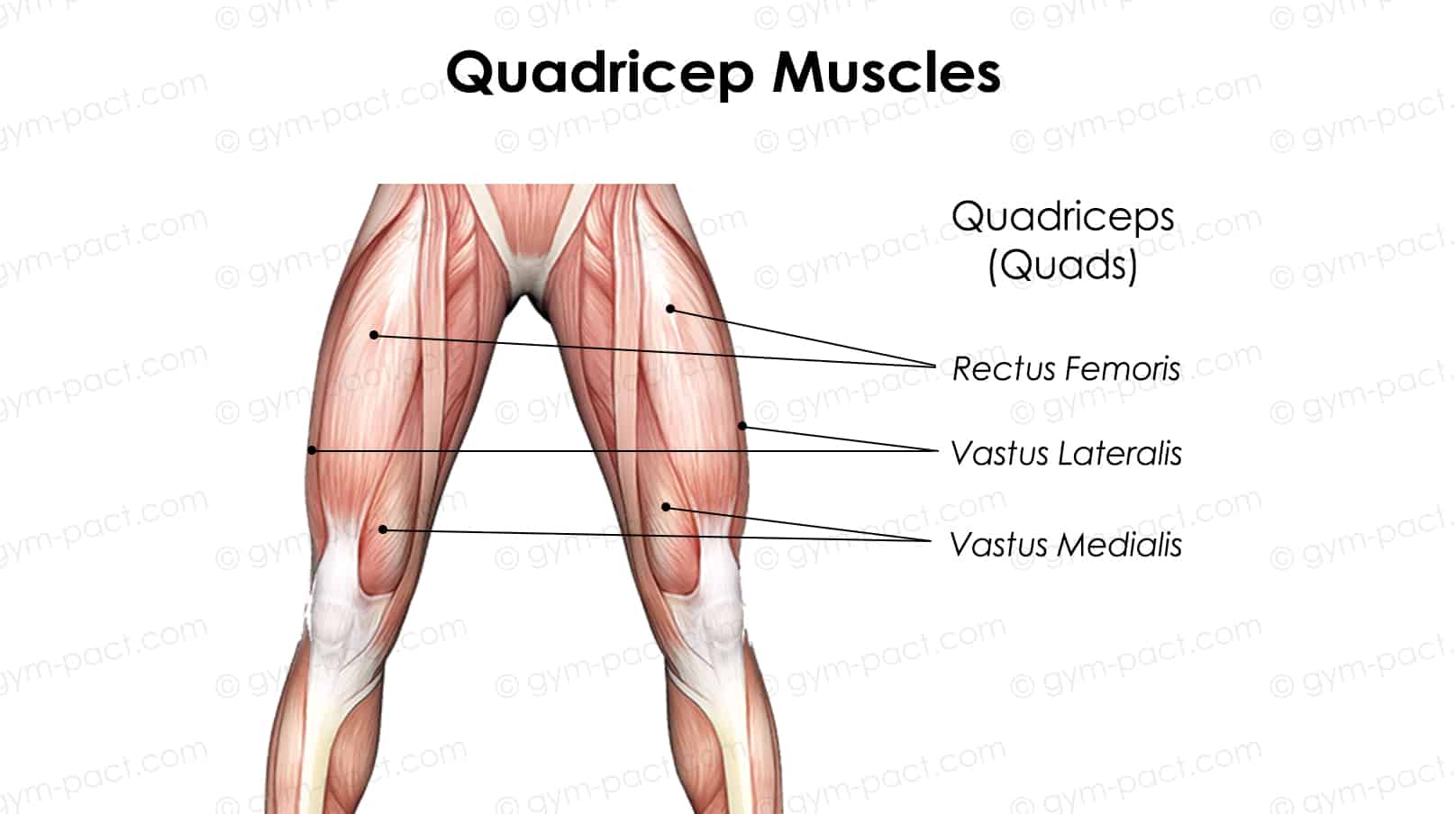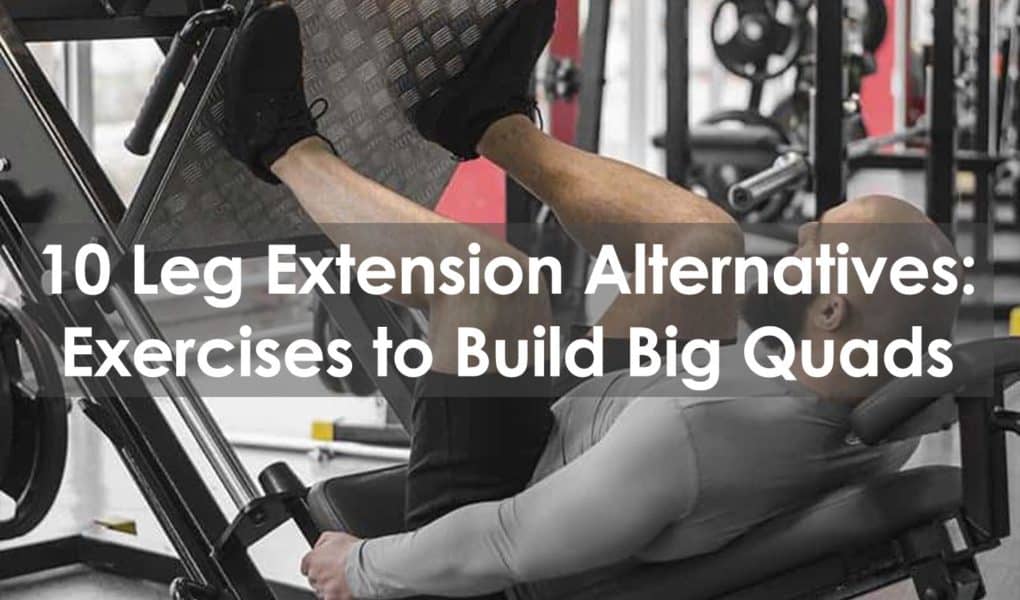The leg extension, your go-to leg day exercise for building big quads. It is the best isolation exercise for muscle growth and strength gains in the quadriceps.
However, maybe your gym doesn’t have a leg extension machine?
Or do you want to add something new to your workout routine? What exercises are going to be a suitable alternative for targeting the quadricep muscles (quads)?

Fortunately, there are many exercises that will stimulate the quad muscle, without having to use fancy machines. Perfect if you train at home or in a CrossFit gym.
Leg extension alternative exercises can be implemented into any of your workouts, whether it is a lower-body workout or a full-body workout, they have a place for building muscle and strength.
Pick and choose which exercises suit your goals and equipment accessibility. Personally, I use these alternatives when the gym is packed out and the leg extension machine is unavailable.
Best Leg Extension Alternatives
1. Bulgarian Split Squats
The Bulgarian split squat is a single-leg movement, targeting your quadriceps, hip flexors, glutes, and hamstrings. The Bulgarian split squat is an excellent leg extension alternative as it uses the elevation of the back leg to provide a greater range of motion to provide maximal stimulation to your quads.
How to perform:
- Begin standing feet shoulder-width apart, holding a dumbbell in each hand.
- Take a long step forward with your left leg, while placing your right foot on a bench behind you.
- Push through your left heel to raise your hips, while remaining in the split stance position.
- Perform 8-12 reps on each leg.
2. Hack Squats
The hack squat uses a machine to mimic a squat movement under a heavy load, ideal for building your leg strength. You will be using all the muscles in your lower body, with emphasis on the quads. The hack squat is a suitable leg extension alternative when other machines are available.
How to perform:
- Begin with your feet shoulder-width apart, with toes slightly outwards.
- Bend your knees slightly, and push your shoulders and lower back into the cushion pad.
- Unlock the safety bar then bend the knees, lowering yourself into the bottom of a squat.
- Push through your heels to return to standing.
- Keep your core tight throughout the movement.
- Perform 8-12 reps.
3. Split Squat
The split squat is a single-leg movement, targeting your quadriceps, hamstrings, and glutes. Single-leg exercises ensure each of your quads is gaining equal strength and size while building stability around the knee joint. Building stability around your knee joints helps lower the risk of injury during exercise and can help prevent knee pain. This makes the split squat a good leg extension alternative.
How to perform:
- Begin standing feet shoulder-width apart, holding a dumbbell in each hand.
- Take a long step forward with your left leg.
- Lower your hips while creating a right angle with your left leg.
- Push through your left heel to raise your hips, while remaining in the split stance position.
- Perform 5-8 reps on each leg.
4. Step-Up
Step-ups focus on single-leg movement with minimal equipment. Step-ups are a suitable leg extension alternative if you train at home or in a CrossFit box. Step-ups can be used to build contralateral power in your quadriceps.
How to perform:
- First set up a box just below knee height.
- Stand with feet hip-width apart in front of the box.
- Place your left foot on the box, then push through your left heel to step up, bringing both feet on to the box.
- Step down with your right foot, controlling your movement to the floor.
- Once your right foot is on the floor, step down with your left foot.
- Perform 8-12 reps on each leg.
5. Cyclist Squat
Cyclist squats are a squat variation involving bringing your feet together and elevating the heels. Playing around with the squat mechanics of cyclist squats puts your quadriceps in prime position for stimulation. There are 4 quad muscles, including the vastus medialis, vastus lateralis, vastus intermedias, and rectus femoris. The cyclist squat will target your vastus medialis, commonly referred to as the ‘teardrop muscle’.
How to perform:
- Begin by placing the heels on a raised surface, such as a weight plate, with feet 4-6 inches apart.
- Hold a dumbbell in each hand.
- Bend at the knees to squat down below parallel, keeping your chest up and core engaged.
- Push through the heels to return to standing, while pushing your knees out.
- Perform 12-15 reps.
6. Bodyweight Squat
Bodyweight squats are one of the fundamental bodyweight exercises for your daily life and training. They work the glutes, hamstrings, calves, core, and quads. They are a suitable leg extension alternative when you have no equipment available.
How to perform:
- Begin with feet shoulder-width apart with feet turned slightly out.
- Push your knees out while sending the hips back, then begin bending the knees, ensuring your thigh is parallel to the floor.
- Drive through the heels to return to standing.
- Make sure you keep your chest up, back straight, and core engaged throughout the movement.
- Perform 12-15 reps.
You can play around with the difficulty of a bodyweight exercise by slowing down parts of the movement. For example, slowly descend into the squat for increased difficulty. You will feel the burn in your leg muscles.
7. Lunges
Lunges are a quad-dominant single-leg exercise. They are a relatively simple movement, suitable for beginner to advanced athletes, relying on little to no equipment. Whatever your training experience, lunges can be put into your workout. Forward lunges place emphasis on your quads, making them a suitable leg extension alternative.
How to perform:
- Begin standing feet shoulder-width apart, holding a dumbbell or kettlebell in each hand.
- Take a long step forward with your left leg.
- Lower your hips while creating a right angle with your left leg.
- Push through your left heel to return to standing.
- Perform 5-8 reps on each leg.
8. Leg Press
The leg press is a machine-based exercise, providing significant stimulation to the quads. The leg press is a suitable leg extension alternative if you prefer the weight to be on your spine. The leg extension places all to load on your quads, which some people find uncomfortable. Placing the load on your spine works the muscle groups in your legs while having the weight in a comfortable position.
How to perform:
- Begin with feet hip-width apart, placed on the plate.
- Push your back, buttock, shoulders, and head back into the machine padding.
- Start with your legs at a 90-degree angle, then press against the plate, extending your legs out.
- Extend your legs to near lockout, pause, then slowly return to the 90-degree position.
- Keep your core engaged throughout the press.
- Perform 8-12 reps.
9. Reverse Lunge
Unlike forward lunges, the reverse lunge place more emphasis on your hamstrings and glutes, however, they still stimulate your quadriceps a significant amount. The reverse lunge creates a greater angle on your front leg, giving the lunge a different biomechanical movement pattern.
How to perform:
- Stand with your feet shoulder-width apart, holding a dumbbell in each hand.
- Take a long step back with your right leg.
- Lower your hips while creating a right angle with your left leg.
- Push through your left heel to return to standing.
- Perform 5-8 reps on each leg.
10. Resistance Band Leg Extensions
Resistance band leg extensions remove the need for a leg extension machine while providing the exact same stimulus and movement pattern. For this movement, all you need is a resistance band and a bench or Glute Ham Developer (GHD), common appliances found in the average CrossFit gym.
How to perform:
- Start by attaching the resistance band to an anchor at ankle height.
- Sit on a bench or Glute Ham Developer machine, then wrap the band around your ankles so you can feel some tension in the band.
- Extend your legs close to lockout before returning to a flexed position.
- Perform 12-15 reps.
Resistance bands are available in a range of tensions, therefore you can play around with load by using different resistance bands.
Conclusion
Leg extensions are a common lower body exercise performed in most athletes’ workout plan. However, you might not have access to a leg extension machine or find the movement repetitive. Don’t threat, there are many leg extension alternatives that provide the necessary stimulus for muscle growth and strength gain.
Leg extension work isn’t the only way to target the quads. Most lower body exercises will stimulate the leg muscles to some degree, including the quadriceps. If you can’t access leg extension machines, don’t worry, there are many movements you can do with little to no equipment, leaving you with no excuses to skip another leg day.
Frequently Asked Questions
How do you do leg extensions safely?
Leg extensions performed incorrectly can lead to knee injuries, therefore the leg extension needs to be performed correctly. Begin in the starting position by sitting in the leg extension machine with your knees aligned with the pivot point of the machine. Rest the front of your ankles on the pad, then perform the leg extension movement by extending your legs to near lockout. Perform 12-15 reps of 2-3 sets.
How can I do leg curls without a machine?
Leg curls can be performed using a resistance band and a bench. To perform resistance band leg curl start by attaching the resistance band to an anchor at ankle height. Lay face down on the bench, then wrap the band around your ankles so you can feel some tension in the band. Start with your legs extended, then curl your legs, bringing your feet to your buttock. Slowly extend legs back to the starting position. Perform 12-15 reps of 2-3 sets.
Do leg extensions increase vertical?
Quadriceps and knee extension play a large role in the vertical jump. The leg extension exercise focuses primarily on the quadriceps muscle and knee extension, therefore is a great exercise to increase the vertical jump.







